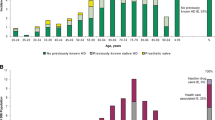Abstract
This paper reviews currently established guidelines for the prevention and treatment of bacterial endocarditis. Endocarditis remains a life-threatening disease with substantial morbidity and mortality. Primary prevention of endocarditis, whenever possible, is therefore very important. In an individual with endocarditis, rapid diagnosis and effective treatment are essential to good patient outcome. The guidelines discussed here are largely based on those issued by the American Heart Association.
While most cases of endocarditis are not attributable to an invasive procedure, certain procedures are associated with bacteraemia by organisms commonly associated with endocarditis, and antibacterial prophylaxis is recommended before such procedures. Patient cardiac conditions are stratified into high, moderate and negligible risk categories based on potential outcome if endocarditis develops. For oral, dental, respiratory tract, and oesophageal procedures (most often associated with viridans streptococci) the standard antibacterial regimen is oral amoxicillin. For gastrointestinal and genitourinary procedures (most often associated with enterococci), parenteral antibacterials are most often recommended. For high-risk patients, intramuscular or intravenous ampicillin and gentamicin (or vancomycin and gentamicin in penicillin-allergic individuals) is recommended. For moderate risk patients, an option of oral amoxicillin or parenteral ampicillin is offered.
Treatment of bacterial endocarditis is guided by identification of the causative micro-organism. Approximately 80% of cases of endocarditis are due to the Gram-positive cocci: streptococci and staphylococci. Other Gram-positive organisms include enterococci (predominantly Enterococcus faecalis and E. faecium) and the HACEK group of organisms (Haemophilus parainfluenzae, H. aphrophilus, Actinobacillus [Haemophilus] actinomycetemcomitans, Cardiobacterium hominis, Eikenella corrodens, and Kingella kingae).
In general, for uncomplicated cases of endocarditis due to penicillin-susceptible viridans streptococci or Streptococcus bovis 4 weeks of benzylpenicillin (or ceftriaxone) is the preferred regimen for most patients aged >65 years. A 2-week course of treatment can be used when gentamicin is added, in patients at low risk for adverse events caused by gentamicin therapy. When endocarditis is caused by strains of viridans streptococci or S. bovis relatively resistant to penicillin, or by enterococci, both benzylpenicillin and gentamicin are recommended. For staphylococcal endocarditis on native heart valves, nafcillin or oxacillin with or without gentamicin is the preferred regimen. In prosthetic valve staphylococcal endocarditis, nafcillin (or oxacillin) with rifampicin and gentamicin is recommended. For all of the above situations, vancomycin is recommended for the patient allergic to penicillin (or methicillin). Finally, consideration of out-of-hospital therapy in selected patients is discussed.




Similar content being viewed by others
References
Watanakunakorn C, Burkert T. Infective endocarditis at a large community teaching hospital: a review of 210 episodes. Medicine (Baltimore) 1993; 72: 90–102
Durack DT. Infective endocarditis. In: Alexander RW, Schlant RC, Fuster V, editors. Hurst’s the heart, arteries and veins. New York: McGraw-Hill, 1998: 2205–39
Berlin JA, Abrutyn E, Strom BL, et al. Incidence of infective endocarditis in the Delaware Valley, 1988–1990. Am J Cardiol 1995; 76: 933–6
American Heart Association. 1997 Heart and Stroke Statistical Update. Dallas (TX): American Heart Association, 1997
Karchmer AW. Infective endocarditis. In: Braunwald E, editor. Heart Disease. 5th ed. Philadelphia (PA): WB Saunders Co., 1997: 1077–104
Weinberger I, Ratts TE, Bisno AL. Native valve infective endocarditis in the 1970s versus the 1980s: underlying cardiac lesions and infecting organisms. Clin Cardiol 1990; 13: 94–8
Bonow RO, Carabello B, de Leon Jr AC, et al. ACC/AHA guidelines for the management of patients with valvular heart disease: a report of the American College of Cardiology/American Heart Association Task Force on Practice Guidelines (Committee on Management of Patients With Valvular Heart Disease). J Am Coll Cardiol 1998; 32: 486–588
Farb A, Virmani R, Burke AP. Pathogenesis and pathology of valvular heart disease. In: Alpert JS, Dalen JE, Rahimtoola SH, editors. Valvular heart disease. Philadelphia (PA): Lippincott Williams & Wilkins, 2000: 1–39
Durack DT, Lukes AS, Bright DK. New criteria for diagnosis of infective endocarditis: utilization of specific echocardio-graphic findings. Duke Endocarditis Service. Am J Med 1994; 96: 200–9
Bayer AS, Bolger AF, Taubert KA, et al. Diagnosis and management of infective endocarditis and its complications. Circulation 1998; 98: 2936–48
Stamboulian D, Carbone E. Recognition, management and prophylaxis of endocarditis. Drugs 1997; 54(5): 730–44
Cheitlin MD, Alpert JS, Armstrong WF, et al. ACC/AHA guidelines for the clinical application of echocardiography: a report of the American College of Cardiology/American Heart Association task force on practice guidelines (Committee on Clinical Application of Echocardiography) developed in collaboration with the American Society of Echocardiography. Circulation 1997; 95: 1686–744
Dajani AS, Taubert KA, Wilson W, et al. Prevention of bacterial endocarditis: recommendations by the American Heart Association. JAMA 1997; 277: 1794–801
Jones TD, Baumgartner L, Bellows MT, et al. Prevention of rheumatic fever and bacterial endocarditis through control of streptococcal infections. Circulation 1955; 11: 317–9
Seto TB, Kwiat D, Taira DA, et al. Physicians’ recommendations to patients for use of antibiotic prophylaxis to prevent endocarditis. JAMA 2000; 284: 68–71
Simmons NA. Recommendations for endocarditis prophylaxis. J Antimicrob Chemother 1993; 31: 437–8
Leport C, Horstkotte D, Burckhardt D, et al. Antibiotic prophylaxis for infective endocarditis from an international group of experts towards a European consensus. Eur Heart J 1995; 16Suppl. B: 126–31
Wilson WR, Karchmer AW, Dajani AS, et al. Antibiotic treatment of adults with infective endocarditis due to streptococci, enterococci, staphylococci, and HACEK microorganisms. JAMA 1995; 274: 1706–13
Murray BE. Vancomycin-resistant enterococcal infections. N Engl J Med 2000; 342: 710–21
Francioli PB. Ceftriaxone and outpatient treatment of infective endocarditis. Infect Dis Clin North Am 1993; 17: 313–22
Huminer D, Bishara J, Pitlik S. Home intravenous antibiotic therapy for patients with infective endocarditis. Eur J Clin Microbiol Infect Dis 1999; 18: 330–4
Gutschik E. New developments in the treatment of infective endocarditis infective cardiovasculitis. Int J Antimicrob Agents 1999; 13: 79–92
Author information
Authors and Affiliations
Corresponding author
Rights and permissions
About this article
Cite this article
Taubert, K.A., Dajani, A.S. Optimisation of the Prevention and Treatment of Bacterial Endocarditis. Drugs & Aging 18, 415–424 (2001). https://doi.org/10.2165/00002512-200118060-00004
Published:
Issue Date:
DOI: https://doi.org/10.2165/00002512-200118060-00004




